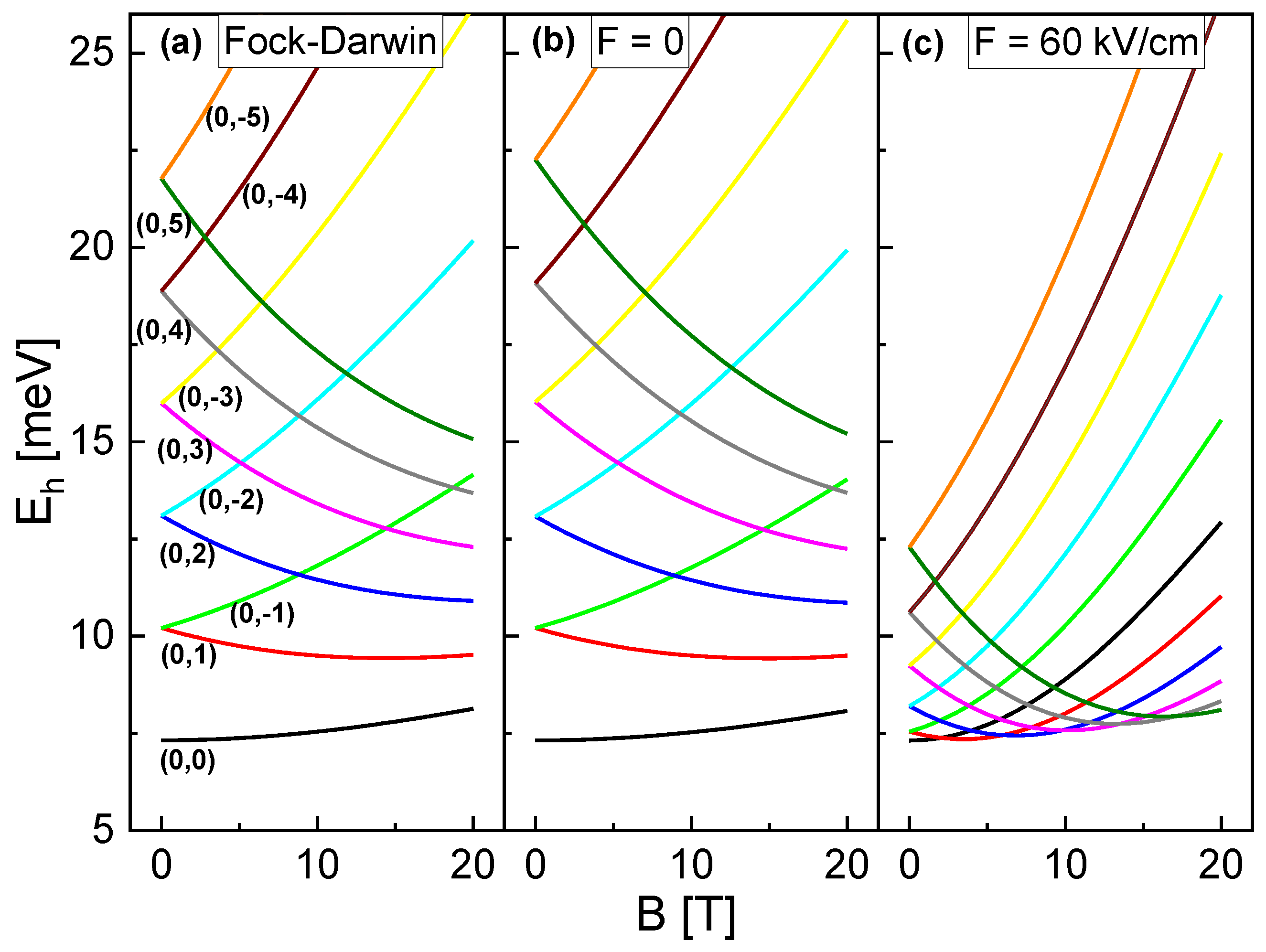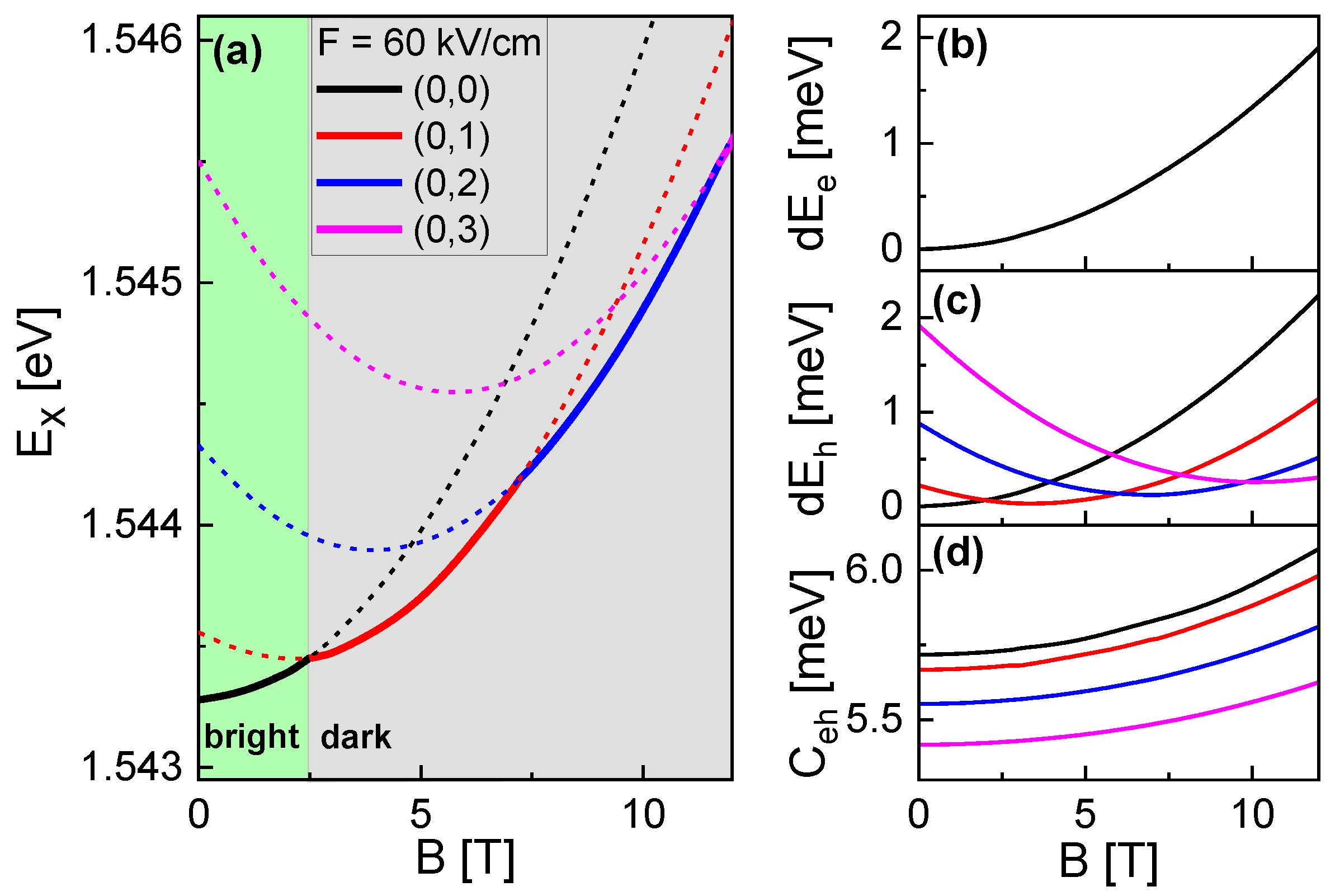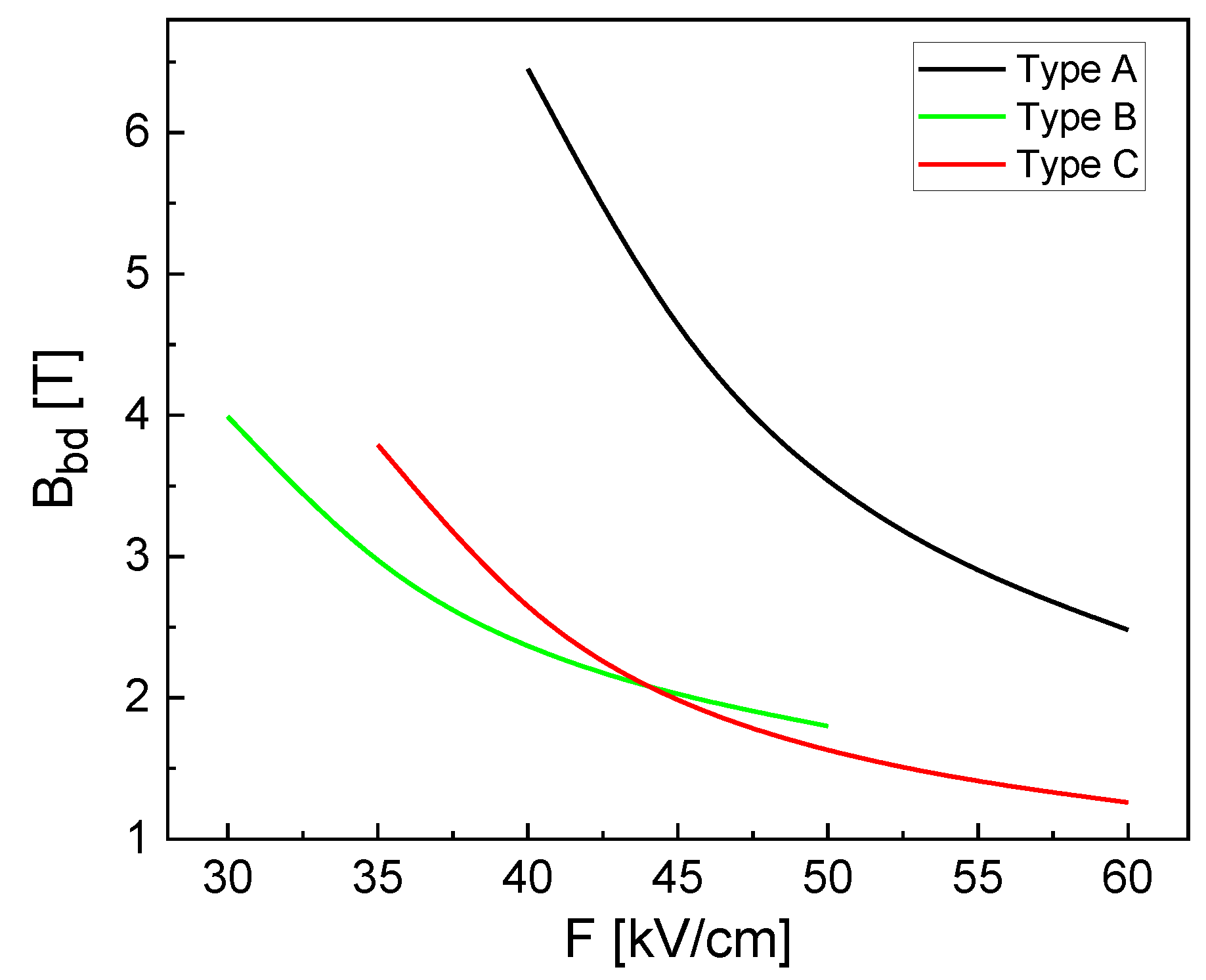Cone-Shell Quantum Structures in Electric and Magnetic Fields as Switchable Traps for Photoexcited Charge Carriers
Abstract
1. Introduction
2. Simulation Model
3. Results and Discussion
3.1. Single-Particle Frame
3.2. Multi-Particle Frame
3.3. Influence of the CSQS Shape
4. Conclusions
Author Contributions
Funding
Data Availability Statement
Acknowledgments
Conflicts of Interest
References
- Maksym, P.A.; Chakraborty, T. Quantum dots in a magnetic field: Role of electron-electron interactions. Phys. Rev. Lett. 1990, 65, 108–111. [Google Scholar] [CrossRef] [PubMed]
- Halonen, V.; Chakraborty, T.; Pietiläinen, P. Excitons in a parabolic quantum dot in magnetic fields. Phys. Rev. B 1992, 45, 5980–5985. [Google Scholar] [CrossRef]
- Kouwenhoven, L.P.; Austing, D.G.; Tarucha, S. Few-electron quantum dots. Rep. Prog. Phys. 2001, 64, 701–736. [Google Scholar] [CrossRef]
- Dreiser, J.; Atatüre, M.; Galland, C.; Müller, T.; Badolato, A.; Imamoglu, A. Optical investigations of quantum dot spin dynamics as a function of external electric and magnetic fields. Phys. Rev. B 2008, 77, 075317. [Google Scholar] [CrossRef]
- Jahan, K.L.; Boda, A.; Shankar, I.V.; Raju, C.N.; Chatterjee, A. Magnetic field effect on the energy levels of an exciton in a GaAs quantum dot: Application for excitonic lasers. Sci. Rep. 2018, 8, 5073. [Google Scholar] [CrossRef] [PubMed]
- Heyn, C.; Duque, C.A. Donor impurity related optical and electronic properties of cylindrical GaAs-AlGaAs quantum dots under tilted electric and magnetic fields. Sci. Rep. 2020, 10, 9155. [Google Scholar] [CrossRef] [PubMed]
- Fock, V. Bemerkung zur Quantelung des harmonischen Oszillators im Magnetfeld. Z. Für Phys. 1928, 47, 446–448. [Google Scholar] [CrossRef]
- Leonard, D.; Krishnamurthy, M.; Fafard, S.; Merz, J.L.; Petroff, P.M. Molecular-beam epitaxy growth of quantum dots from strained coherent uniform islands of InGaAs on GaAs. J. Vac. Sci. Technol. B Microelectron. Nanometer Struct. Process. Meas. Phenom. 1994, 12, 1063–1066. [Google Scholar] [CrossRef]
- Madhukar, A.; Xie, Q.; Chen, P.; Konkar, A. Nature of strained InAs three-dimensional island formation and distribution on GaAs(100). Appl. Phys. Lett. 1994, 64, 2727–2729. [Google Scholar] [CrossRef]
- Moison, J.M.; Houzay, F.; Barthe, F.; Leprince, L.; André, E.; Vatel, O. Self-organized growth of regular nanometer-scale InAs dots on GaAs. Appl. Phys. Lett. 1994, 64, 196–198. [Google Scholar] [CrossRef]
- Eisele, H.; Lenz, A.; Heitz, R.; Timm, R.; Dähne, M.; Temko, Y.; Suzuki, T.; Jacobi, K. Change of InAs/GaAs quantum dot shape and composition during capping. J. Appl. Phys. 2008, 104, 124301. [Google Scholar] [CrossRef]
- Bietti, S.; Bocquel, J.; Adorno, S.; Mano, T.; Keizer, J.G.; Koenraad, P.M.; Sanguinetti, S. Precise shape engineering of epitaxial quantum dots by growth kinetics. Phys. Rev. B 2015, 92, 075425. [Google Scholar] [CrossRef]
- Gajjela, R.S.R.; Koenraad, P.M. Atomic-Scale Characterization of Droplet Epitaxy Quantum Dots. Nanomaterials 2021, 11, 85. [Google Scholar] [CrossRef] [PubMed]
- Heyn, C.; Ranasinghe, L.; Deneke, K.; Alshaikh, A.; Duque, C.A.; Hansen, W. Strong Electric Polarizability of Cone–Shell Quantum Structures for a Large Stark Shift, Tunable Long Exciton Lifetimes, and a Dot-to-Ring Transformation. Nanomaterials 2023, 13, 857. [Google Scholar] [CrossRef] [PubMed]
- Heyn, C.; Stemmann, A.; Köppen, T.; Strelow, C.; Kipp, T.; Grave, M.; Mendach, S.; Hansen, W. Highly uniform and strain-free GaAs quantum dots fabricated by filling of self-assembled nanoholes. Appl. Phys. Lett. 2009, 94, 183113–183115. [Google Scholar] [CrossRef]
- Heyn, C.; Gräfenstein, A.; Pirard, G.; Ranasinghe, L.; Deneke, K.; Alshaikh, A.; Bester, G.; Hansen, W. Dot-Size Dependent Excitons in Droplet-Etched Cone-Shell GaAs Quantum Dots. Nanomaterials 2022, 12, 2981. [Google Scholar] [CrossRef]
- Aharonov, Y.; Bohm, D. Significance of Electromagnetic Potentials in the Quantum Theory. Phys. Rev. 1959, 115, 485–491. [Google Scholar] [CrossRef]
- Bennett, A.J.; Patel, R.B.; Joanna, S.S.; Christine A., N.; David A., F.; Andrew J., S. Giant Stark effect in the emission of single semiconductor quantum dots. Appl. Phys. Lett. 2010, 97, 031104. [Google Scholar] [CrossRef]
- Fomin, V.M. Physics of Quantum Rings; Springer: Berlin/Heidelberg, Germany, 2018. [Google Scholar]
- Kleemans, N.A.J.M.; Bominaar-Silkens, I.M.A.; Fomin, V.M.; Gladilin, V.N.; Granados, D.; Taboada, A.G.; García, J.M.; Offermans, P.; Zeitler, U.; Christianen, P.C.M.; et al. Oscillatory Persistent Currents in Self-Assembled Quantum Rings. Phys. Rev. Lett. 2007, 99, 146808. [Google Scholar] [CrossRef]
- Lorke, A.; Johannes Luyken, R.; Govorov, A.O.; Kotthaus, J.P.; Garcia, J.M.; Petroff, P.M. Spectroscopy of Nanoscopic Semiconductor Rings. Phys. Rev. Lett. 2000, 84, 2223–2226. [Google Scholar] [CrossRef]
- Chaplik, A.V. Aharonov-Bohm effect for composite particles and collective excitations. J. Exp. Theor. Phys. Lett. 2002, 75, 292–296. [Google Scholar] [CrossRef]
- Govorov, A.O.; Ulloa, S.E.; Karrai, K.; Warburton, R.J. Polarized excitons in nanorings and the optical Aharonov-Bohm effect. Phys. Rev. B 2002, 66, 081309. [Google Scholar] [CrossRef]
- Fischer, A.M.; Campo, V.L.; Portnoi, M.E.; Römer, R.A. Exciton Storage in a Nanoscale Aharonov-Bohm Ring with Electric Field Tuning. Phys. Rev. Lett. 2009, 102, 096405. [Google Scholar] [CrossRef] [PubMed]
- Li, B.; Peeters, F.M. Tunable optical Aharonov-Bohm effect in a semiconductor quantum ring. Phys. Rev. B 2011, 83, 115448. [Google Scholar] [CrossRef]
- Ding, F.; Akopian, N.; Li, B.; Perinetti, U.; Govorov, A.; Peeters, F.M.; Bof Bufon, C.C.; Deneke, C.; Chen, Y.H.; Rastelli, A.; et al. Gate controlled Aharonov-Bohm-type oscillations from single neutral excitons in quantum rings. Phys. Rev. B 2010, 82, 075309. [Google Scholar] [CrossRef]
- Ribeiro, E.; Govorov, A.O.; Carvalho, W.; Medeiros-Ribeiro, G. Aharonov-Bohm Signature for Neutral Polarized Excitons in Type-II Quantum Dot Ensembles. Phys. Rev. Lett. 2004, 92, 126402. [Google Scholar] [CrossRef] [PubMed]
- Sellers, I.R.; Whiteside, V.R.; Kuskovsky, I.L.; Govorov, A.O.; McCombe, B.D. Aharonov-Bohm Excitons at Elevated Temperatures in Type-II ZnTe/ZnSe Quantum Dots. Phys. Rev. Lett. 2008, 100, 136405. [Google Scholar] [CrossRef]
- Llorens, J.; Lopes-Oliveira, V.; López-Richard, V.; de Oliveira, E.C.; Wewiór, L.; Ulloa, J.; Teodoro, M.; Marques, G.; García-Cristóbal, A.; Hai, G.Q.; et al. Topology Driven g-Factor Tuning in Type-II Quantum Dots. Phys. Rev. Appl. 2019, 11, 044011. [Google Scholar] [CrossRef]






Disclaimer/Publisher’s Note: The statements, opinions and data contained in all publications are solely those of the individual author(s) and contributor(s) and not of MDPI and/or the editor(s). MDPI and/or the editor(s) disclaim responsibility for any injury to people or property resulting from any ideas, methods, instructions or products referred to in the content. |
© 2023 by the authors. Licensee MDPI, Basel, Switzerland. This article is an open access article distributed under the terms and conditions of the Creative Commons Attribution (CC BY) license (https://creativecommons.org/licenses/by/4.0/).
Share and Cite
Heyn, C.; Ranasinghe, L.; Alshaikh, A.; Duque, C.A. Cone-Shell Quantum Structures in Electric and Magnetic Fields as Switchable Traps for Photoexcited Charge Carriers. Nanomaterials 2023, 13, 1696. https://doi.org/10.3390/nano13101696
Heyn C, Ranasinghe L, Alshaikh A, Duque CA. Cone-Shell Quantum Structures in Electric and Magnetic Fields as Switchable Traps for Photoexcited Charge Carriers. Nanomaterials. 2023; 13(10):1696. https://doi.org/10.3390/nano13101696
Chicago/Turabian StyleHeyn, Christian, Leonardo Ranasinghe, Ahmed Alshaikh, and Carlos A. Duque. 2023. "Cone-Shell Quantum Structures in Electric and Magnetic Fields as Switchable Traps for Photoexcited Charge Carriers" Nanomaterials 13, no. 10: 1696. https://doi.org/10.3390/nano13101696
APA StyleHeyn, C., Ranasinghe, L., Alshaikh, A., & Duque, C. A. (2023). Cone-Shell Quantum Structures in Electric and Magnetic Fields as Switchable Traps for Photoexcited Charge Carriers. Nanomaterials, 13(10), 1696. https://doi.org/10.3390/nano13101696





